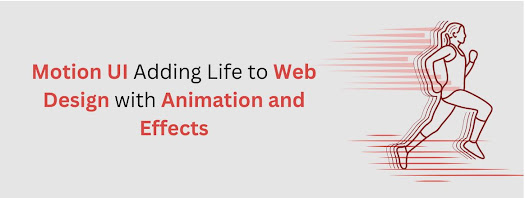Motion UI: Adding Life to Web Design with Animation and Effects
In the dynamic world of web design, the ability to captivate and engage users is paramount. One of the most effective ways to achieve this is through Motion UI, which brings websites to life with animations and effects. As the Best web design and development company in Pune, Appristine is at the forefront of leveraging Motion UI to enhance user experiences. This blog delves into the essence of Motion UI, its workings, types, principles, benefits, and how Appristine utilizes this technology to create stunning web designs.
What is Motion UI? Motion UI, or Motion User Interface, refers to the incorporation of animations and transitions within a user interface to improve the user experience. These animations are not merely decorative; they serve functional purposes such as guiding user attention, providing feedback, and enhancing navigation. Motion UI transforms static web elements into interactive and engaging components, making websites more intuitive and enjoyable to use. How Motion UI Works? Motion UI operates by applying animations and transitions to various elements on a website. These animations can be triggered by user interactions such as clicks, hovers, or scrolling, or they can occur automatically to draw attention to specific elements. Motion UI is typically implemented using CSS, JavaScript, or specialized animation libraries like GreenSock (GSAP) and Animate.css. By defining keyframes and animation properties, designers can create smooth and dynamic visual effects that enhance the overall user experience. Types of Animations for Web Design Functional Animation Functional animations serve a specific purpose within the user interface. They guide users, provide feedback, and make interactions more intuitive. Examples include button clicks, form validations, and notifications. Decorative Interface Animation These animations add aesthetic value to a website without necessarily serving a functional purpose. They enhance the visual appeal and create a memorable user experience. Examples include background animations, hover effects, and decorative loading spinners. Transitional Animation Transitional animations smooth out the changes between different states of a user interface. They help users understand the relationship between elements and maintain their context within the site. Examples include page transitions, modal pop-ups, and menu slide-ins. 3D Animations 3D animations add depth and realism to web designs. They can be used for product showcases, interactive infographics, and immersive user experiences. These animations often require advanced techniques and tools such as WebGL and Three.js. Principles of Animation in UI/UX Design Anticipation- Anticipation prepares users for an upcoming action. For example, a button might slightly enlarge before being clicked, signaling its interactivity.
- Staging directs the user’s attention to the most important elements. This principle ensures that animations are clear and easily understandable.
- The timing and duration of animations are crucial for creating a smooth user experience. Animations should be neither too fast nor too slow, striking a balance that feels natural.
- Easing refers to the acceleration and deceleration of an animation. Proper easing makes animations feel more realistic and less mechanical.
- Animations provide feedback to user actions, confirming that the system has registered their input. This enhances the sense of control and satisfaction for the user.
- Motion UI captures users' attention and keeps them engaged. Animated elements are more likely to retain interest compared to static ones, leading to longer site visits.
- Animations can guide users' attention to critical areas of a website, such as call-to-action buttons, new features, or important notifications.
- Motion UI helps establish a clear visual hierarchy by emphasizing the most important elements first. This improves the overall usability of the site.
- Interactive animations respond to user actions, making the site feel more responsive and intuitive. Transitions smooth out changes, making the navigation experience seamless.
- Parallax scrolling creates a sense of depth and immersion, enhancing the storytelling aspect of web design. It makes the browsing experience more engaging and enjoyable.
- Smooth scrolling and page transitions enhance the overall user experience by providing a fluid and cohesive navigation experience.
- Drop-down Menus: Drop-down menus with smooth animations make navigation more intuitive and visually appealing. They can also provide subtle feedback, such as highlighting the selected menu item.
- Transition Effects between Pages and Sections of a Website: Transition effects create a seamless experience as users move between different sections or pages, reducing cognitive load and maintaining context.
- Animated Form Validation: Animated form validation provides immediate feedback to users, indicating errors or successful inputs. This improves the form-filling experience and reduces frustration.
- Progress Bars or Loading Spinners: Progress bars and loading spinners keep users informed about the status of their actions, such as file uploads or page loads, enhancing perceived performance.
- Animated Infographics that Dynamically Convey Information: Animated infographics make complex information more digestible and engaging. They can illustrate data trends, processes, and other information dynamically.
- Using Rotations and Zoom Animations: Rotations and zoom animations can showcase products from different angles, providing a more comprehensive view and enhancing the shopping experience.
- Product Demos and Animations to Showcase Product Benefits: Product demos with animations can highlight key features and benefits, making it easier for users to understand the value of the product.
- Product Comparison Tools with Interactive and Dynamic Visual Elements: Interactive product comparison tools allow users to compare features dynamically, aiding in decision-making.



Comments
Post a Comment